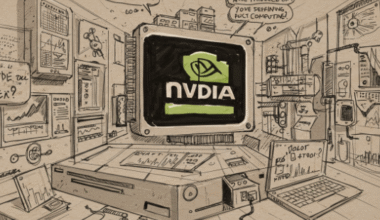Stock Symbol: ORCL | Current Price: ~$170 (September 2025) | Target Price: $273+ | Timeframe: 12-18 months
Executive Summary
Oracle Corporation stands at the precipice of a transformational period that could drive unprecedented growth through 2026. Once primarily known as a database company, Oracle has quietly positioned itself as the “fourth AI hyperscaler” alongside Amazon, Microsoft, and Google. With a massive $138 billion backlog, aggressive cloud infrastructure expansion, and strategic partnerships with industry leaders like OpenAI, Oracle represents one of the most compelling investment opportunities in the enterprise technology space.
Investment Thesis: The AI Infrastructure Revolution
The Core Opportunity
Oracle’s investment thesis centers on three fundamental pillars that position it for explosive growth in 2026:
1. AI Infrastructure Dominance Oracle has emerged as a critical infrastructure provider for artificial intelligence workloads. The company’s Oracle Cloud Infrastructure (OCI) has become the go-to platform for AI companies seeking alternatives to the saturated capacity of AWS, Azure, and Google Cloud.
2. Strategic Partnerships Driving Exponential Growth The landmark partnership with OpenAI represents more than just another customer win – it validates Oracle’s position as a tier-one AI infrastructure provider and opens the door to similar partnerships with other AI leaders.
3. Massive Capital Investment Creating Moats Oracle’s commitment to investing over $25 billion in capital expenditures demonstrates unprecedented confidence in future demand and creates significant barriers to entry for competitors.
Key Growth Catalysts for 2026

1. The OpenAI Partnership: A Game-Changing Alliance
Oracle’s partnership with OpenAI extends far beyond traditional cloud services. Key highlights include:
- Stargate Project Partnership: Oracle is participating in OpenAI’s $500 billion Stargate Project, contributing 4.5 gigawatts of data center capacity
- Combined Capacity: Together with existing partnerships, Oracle will operate over 5 gigawatts of AI data center capacity, supporting over 2 million AI chips
- Revenue Multiplier Effect: This partnership positions Oracle to capture significant revenue from the AI boom while establishing long-term relationships with cutting-edge AI companies
2. Oracle Cloud Infrastructure (OCI) Explosive Growth
The numbers tell a compelling story:
- 77% Growth Projection: Oracle forecasts OCI will grow 77% in fiscal 2026, reaching $18 billion in revenue
- Market Share Gains: OCI is capturing market share from hyperscale competitors by offering specialized AI infrastructure
- Capacity Leadership: Oracle was the single largest lessor of datacenter capacity in the US from November 2023 to January 2025, committing over 2GW of capacity
3. Unprecedented Remaining Performance Obligations (RPO)
Oracle’s backlog provides exceptional visibility into future revenue:
- Current Backlog: $138 billion in remaining performance obligations
- Growth Trajectory: RPO expected to surpass $500 billion, indicating sustained demand
- Revenue Quality: Long-term contracts provide predictable, recurring revenue streams
Financial Performance and Projections
Recent Financial Highlights
Fiscal 2025 Performance:
- Total Revenue: $57.4 billion (up 8% year-over-year)
- Cloud Revenue Growth: Consistent double-digit growth across all cloud segments
- Capital Expenditure: Over $21 billion (vs. less than $7 billion in fiscal 2024)
Q1 2026 Momentum:
- Strong bookings following OpenAI deal announcement
- Stock gained 45% through September 2025
- Record-breaking single-day gains of 30%+ following earnings announcements
2026 Financial Projections
Based on current trajectory and announced partnerships:
Revenue Projections:
- Total Revenue: $65-70 billion (13-22% growth)
- OCI Revenue: $18 billion (77% growth as guided)
- Cloud Services: $35-40 billion total
Profitability Metrics:
- Operating Margin: Expected improvement due to cloud mix shift
- EPS Growth: 15-20% annual growth sustainable through 2026
- Free Cash Flow: Strong generation supporting continued capex investment
Competitive Advantages and Market Position
1. Specialized AI Infrastructure
Unlike general-purpose cloud providers, Oracle has purpose-built infrastructure specifically for AI workloads:
- High-Performance Computing: Optimized for training large language models
- Network Architecture: Superior interconnect technology for distributed AI training
- Cost Efficiency: More competitive pricing for AI-specific workloads
2. Enterprise Customer Base
Oracle’s existing enterprise relationships provide a significant advantage:
- Trusted Partner: Decades of enterprise relationships facilitate cloud migration
- Integrated Solutions: Database and applications create switching costs
- Global Reach: Worldwide data center presence supports multinational clients
3. Strategic Partnerships Beyond OpenAI
- Microsoft Azure Integration: Hybrid cloud solutions expanding addressable market
- Google Cloud Partnerships: Multi-cloud strategies increasing customer flexibility
- Industry-Specific Solutions: Targeted offerings for healthcare, financial services, and government
Risk Factors and Mitigation Strategies
Primary Risks
1. Capital Intensity
- Risk: Massive capex requirements strain cash flow
- Mitigation: Strong free cash flow generation and proven ROI on infrastructure investments
2. Competitive Pressure
- Risk: AWS, Microsoft, and Google expanding AI infrastructure capacity
- Mitigation: Differentiated offerings and established customer relationships
3. Economic Sensitivity
- Risk: Economic downturn could reduce enterprise IT spending
- Mitigation: Long-term contracts and mission-critical nature of database services
4. Execution Risk
- Risk: Failure to deliver on ambitious growth projections
- Mitigation: Conservative guidance history and experienced management team
Technical Analysis and Price Targets
Current Valuation Metrics
- P/E Ratio: Trading at reasonable multiple relative to growth prospects
- Price-to-Sales: Below historical averages despite improved growth profile
- Enterprise Value/EBITDA: Attractive relative to cloud infrastructure peers
Price Targets and Catalysts
Near-term Catalysts (Q4 2025 – Q2 2026):
- Q2 2026 earnings demonstrating OCI growth acceleration
- Additional AI partnership announcements
- Stargate Project deployment milestones
12-Month Price Target: $240-260 18-Month Price Target: $270-290
Analyst consensus target: $273 per share
Investment Recommendation
Rating: STRONG BUY
Oracle represents a unique opportunity to invest in a established enterprise technology leader that is successfully pivoting to capture the AI infrastructure opportunity. The combination of:
- Massive contracted revenue backlog
- Strategic partnerships with AI leaders
- Aggressive infrastructure investment
- Proven execution capability
Creates a compelling investment case for significant outperformance through 2026.
Suggested Investment Strategy
For Growth Investors:
- Target allocation: 3-5% of technology portfolio
- Entry strategy: Dollar-cost average on any weakness below $180
- Hold period: 18-24 months minimum
For Income Investors:
- Dividend yield: Modest but growing dividend
- Total return focus: Capital appreciation primary driver
- Risk level: Moderate to high due to capex cycle
Key Milestones to Monitor
Q4 2025:
- OCI revenue growth trajectory
- Updated RPO figures
- Stargate Project progress updates
2026:
- AI partnership expansion
- Market share gains in cloud infrastructure
- Profitability improvement from scale
Conclusion
Oracle’s transformation from a traditional database company to an AI infrastructure powerhouse positions it as one of the most compelling investment opportunities for 2026. The company’s strategic partnerships, massive investment in infrastructure, and substantial contracted revenue backlog create multiple pathways to significant stock price appreciation.
While risks exist, particularly around capital intensity and competitive pressure, Oracle’s execution track record and differentiated market position provide confidence in the investment thesis. For investors seeking exposure to the AI infrastructure boom through an established enterprise technology leader, Oracle represents an attractive entry point into one of technology’s fastest-growing segments.
Disclaimer: This analysis is for informational purposes only and should not be considered personalized investment advice. Past performance does not guarantee future results. Please consult with a qualified financial advisor before making investment decisions.
Last Updated: September 2025
Next Review: December 2025







